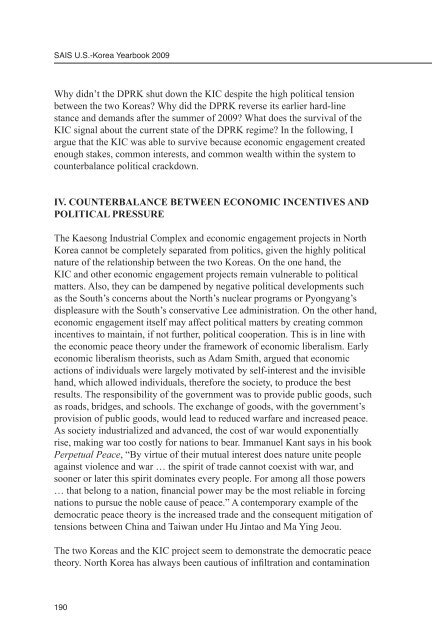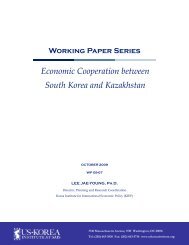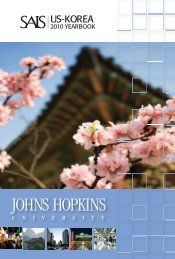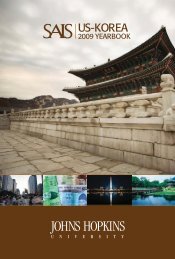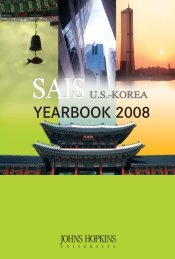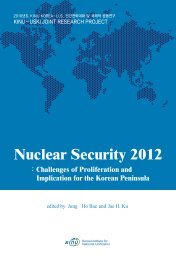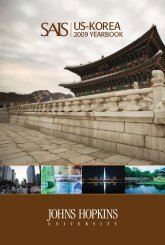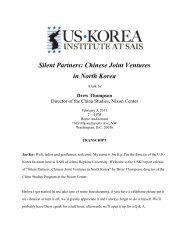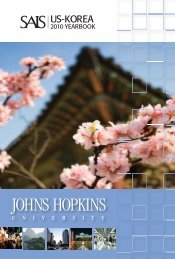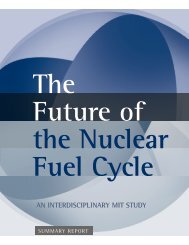Kaesong Industrial Complex - US-Korea Institute at SAIS
Kaesong Industrial Complex - US-Korea Institute at SAIS
Kaesong Industrial Complex - US-Korea Institute at SAIS
Create successful ePaper yourself
Turn your PDF publications into a flip-book with our unique Google optimized e-Paper software.
<strong>SAIS</strong> U.S.-<strong>Korea</strong> Yearbook 2009Why didn’t the DPRK shut down the KIC despite the high political tensionbetween the two <strong>Korea</strong>s? Why did the DPRK reverse its earlier hard-linestance and demands after the summer of 2009? Wh<strong>at</strong> does the survival of theKIC signal about the current st<strong>at</strong>e of the DPRK regime? In the following, Iargue th<strong>at</strong> the KIC was able to survive because economic engagement cre<strong>at</strong>edenough stakes, common interests, and common wealth within the system tocounterbalance political crackdown.IV. COUNTERBALANCE BETWEEN ECONOMIC INCENTIVES ANDPOLITICAL PRESSUREThe <strong>Kaesong</strong> <strong>Industrial</strong> <strong>Complex</strong> and economic engagement projects in North<strong>Korea</strong> cannot be completely separ<strong>at</strong>ed from politics, given the highly politicaln<strong>at</strong>ure of the rel<strong>at</strong>ionship between the two <strong>Korea</strong>s. On the one hand, theKIC and other economic engagement projects remain vulnerable to politicalm<strong>at</strong>ters. Also, they can be dampened by neg<strong>at</strong>ive political developments suchas the South’s concerns about the North’s nuclear programs or Pyongyang’sdispleasure with the South’s conserv<strong>at</strong>ive Lee administr<strong>at</strong>ion. On the other hand,economic engagement itself may affect political m<strong>at</strong>ters by cre<strong>at</strong>ing commonincentives to maintain, if not further, political cooper<strong>at</strong>ion. This is in line withthe economic peace theory under the framework of economic liberalism. Earlyeconomic liberalism theorists, such as Adam Smith, argued th<strong>at</strong> economicactions of individuals were largely motiv<strong>at</strong>ed by self-interest and the invisiblehand, which allowed individuals, therefore the society, to produce the bestresults. The responsibility of the government was to provide public goods, suchas roads, bridges, and schools. The exchange of goods, with the government’sprovision of public goods, would lead to reduced warfare and increased peace.As society industrialized and advanced, the cost of war would exponentiallyrise, making war too costly for n<strong>at</strong>ions to bear. Immanuel Kant says in his bookPerpetual Peace, “By virtue of their mutual interest does n<strong>at</strong>ure unite peopleagainst violence and war … the spirit of trade cannot coexist with war, andsooner or l<strong>at</strong>er this spirit domin<strong>at</strong>es every people. For among all those powers… th<strong>at</strong> belong to a n<strong>at</strong>ion, financial power may be the most reliable in forcingn<strong>at</strong>ions to pursue the noble cause of peace.” A contemporary example of thedemocr<strong>at</strong>ic peace theory is the increased trade and the consequent mitig<strong>at</strong>ion oftensions between China and Taiwan under Hu Jintao and Ma Ying Jeou.The two <strong>Korea</strong>s and the KIC project seem to demonstr<strong>at</strong>e the democr<strong>at</strong>ic peacetheory. North <strong>Korea</strong> has always been cautious of infiltr<strong>at</strong>ion and contamin<strong>at</strong>ion190


